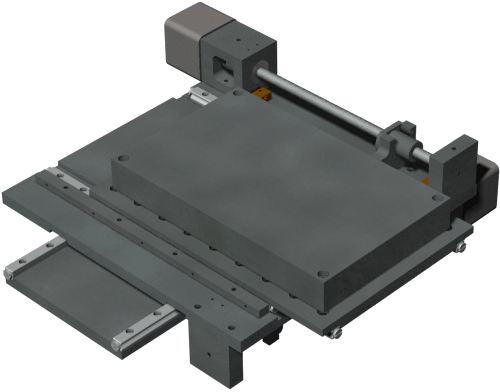Microscope Stages
Stages are based on a platform system designed and built by TriTek. Plates are moved using precision screws with mechanical interfaces comprised of crossed-roller guides. Standard stages are available with travel ranges from 50mm (2 inches) to 914mm (36 inches). There are 3 specifications that are germane to an analysis of movement precision of microscope stages: resolution, repeatability, and absolute positional accuracy. Thermal displacement, the effects of temperature variation, must be considered to quantify these parameters as a typical 200mm screw will lengthen by 12µm with a 5°C temperature rise.
Precision lead screws are available with runout errors of +/-10 µm/100mm and rolling errors less than 10% of runout error. Because the rolling error is much less than the runout error, the absolute accuracy of a lead screw stage is easily improved via software correction tables. ISO/DIN Class III ball screws are available with runout errors of +/-8 µm/100mm for the shorter lengths to 2.1µm/100mm for the longer lengths. Total error can not be corrected via software since the rolling error varies widely and is typically 70-100% of the runout error. Either ball screws or precision lead screws are used for stage movement. Accuracies and screw pitches are available over a wide range, as required by the application. The stepper motor drivers can be programmed to operate in half step mode or they can be programmed to microstep in 1/4, 1/8, 1/16, 1/32, 1/64, 1/128, or 1/256 increments. Minimum stage movement (resolution) versus stage transport time usually determines the lead screw pitch and stepper motor resolution. The major criterion to be considered when determining application accuracy requirements for a stage is the capability to relocate an anomaly that has been specified to be at a particular x,y coordinate. The field-of-view of a typical system is approximately 60µ x 45µm when using the highest magnification objective (100x), therefore, absolute accuracy of 25µm should suffice for most applications. This accuracy will assure that the feature of interest is within the center area of the field of view at the highest magnification. |


